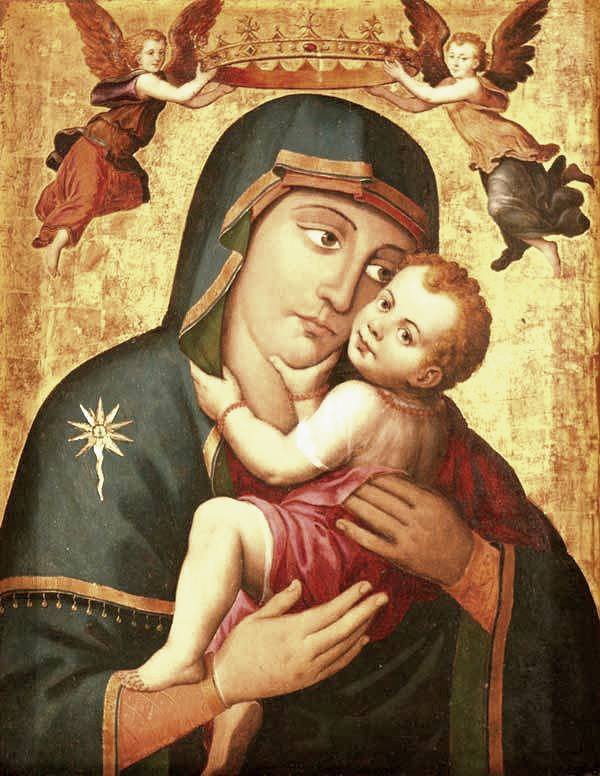
An article by Patrick McMahon, O.Carm.
“Mary was profoundly important to the hermits. The chapel on Mount Carmel was dedicated to her; she was the Lady of the Place, to whom the hermits had a particular loyalty. (Of course, Mary was the most common object of dedication and titling of Churches in this period.) The hermits were known as her hermits, her brothers…
 Right from the beginning of the Order the Carmelites most likely saw Mary as the protector. Their church, on the frontier of the Saracen world, was not put under the patronage of the warrior saints who could defend it with arms, saints such as Michael or George. It was to Mary that they entrusted themselves and their foundation.
Right from the beginning of the Order the Carmelites most likely saw Mary as the protector. Their church, on the frontier of the Saracen world, was not put under the patronage of the warrior saints who could defend it with arms, saints such as Michael or George. It was to Mary that they entrusted themselves and their foundation.
The most important defense of the Carmelite Order that its heavenly patroness would have to mount was not against the Saracens, however, but against the hierarchy. At the second Council of Lyons in 1274 the Carmelites and Augustinians were threatened with suppression by the assembled cardinals, bishops, and abbots. The monks and diocesan clergy did not like the mendicants who were very popular with the common people. Vocations and financial support were going to these new orders rather than the traditional ones. The Dominicans and Franciscans were too big and too close to the papacy for their enemies to eliminate, but the Carmelites and Augustinians were easy pickings. The strategy was simple. Lateran IV had decreed in 1215 that there should be no new religious orders. The Augustinians were clearly instituted after this date having been formed by the Great Union of 1256 uniting a number of Italian hermit communities under the Rule of Augustine. The Carmelites, for their part, claimed to predate the ban but the Holy See had no record of them before 1226. The two small mendicant orders would simply be abolished as having been founded contrary to the canons of Lateran IV.
The larger mendicant orders, the Franciscans and Dominicans, were reluctant to help the two smaller orders. The smaller orders provided a scapegoat to satisfy the blood lust of the mendicants’ enemies. … The Augustinians had a cardinal friend, Riccardo Annibaldi, who worked hard on their behalf, but the Carmelites were more or less on their own. Their only help could come from their heavenly patroness. The date was set for the canon suppressing the order to be presented to the Council: July 17. It would take a miracle.
The miracle came through, though it is not clear exactly how. Perhaps it was the confusion in the council caused by the death of one of the leading members of the papal household and council fathers, the Franciscan Cardinal (Saint) Bonaventure of Bagnoreggio in the night of July 15. Whatever the cause, the decree of the council changed substantially. Whereas the text scheduled to be presented on July 17 read, “The Orders of the Carmelites and of the Hermits of Saint Augustine who allege that they had been founded before the said Council…”, the final text promulgated by the pope on November 21 read, “The foundation of the Orders of the Carmelites and the Hermits of Saint Augustine took place prior to the said general council…” In other words, the argument for suppressing the two orders was undermined in the definitive canon and they were given a reprieve. Although that reprieve was not made permanent until 1298, the order’s closest brush with extinction (though not its last) was overcome. The Carmelites had a close call, and they remembered the deliverance that Mary’s protection had won them. Cicconetti claims that from 1274 on the Carmelites associated July 17 with deep gratitude to our Blessed Lady for her protection. This deliverance could not be celebrated on July 17, the feast of the very popular (in the Middle Ages) Saint Alexis, so it came to be celebrated on July 16. It was only in the late fourteenth century that this date replaced August 15 as the preeminent feast in honor of the Virgin for Carmelites. As the scapular stories emerge, the date July 16 will be associated not only with Mary’s protection of the Order, but explicitly with the conferral of the sign of that protection, the scapular, to Saint Simon Stock.”
Go Ahead, Leave A Comment